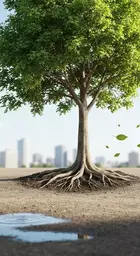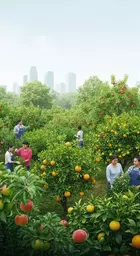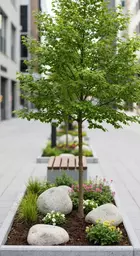Urban Trees and Carbon Capture

Posted on: 2025-07-09
By: Keira Vallejo
As urban populations continue to grow, the importance of trees in our cities cannot be overstated. They are not merely decorative elements; they play a vital role in combating climate change and improving our overall quality of life. The pressing question remains: How can we harness the power of urban trees to create healthier environments for ourselves and future generations?
What You Will Learn
- Urban trees absorb approximately 48 pounds of CO₂ per year, making them critical players in carbon capture.
- Selecting the right tree species, like the London Plane or Red Maple, enhances carbon sequestration efforts in urban areas.
- Healthy urban forests improve air quality by filtering pollutants and providing shade, which lowers temperatures and reduces ground-level ozone formation.
- Community involvement in tree planting and care fosters a sense of ownership and helps sustain local biodiversity.
- Innovative technologies and community-led initiatives are crucial for advancing urban tree carbon management and greening efforts.
The Impact of Urban Trees on Carbon Capture and Air Quality
Urban trees play a crucial role in carbon sequestration and improving air quality, as showcased in the comparisons below.
Carbon Sequestration Rates of Urban Trees
- London Plane: 1 ton of CO₂ absorbed over its lifespan
- Red Maple: 1 ton of CO₂ absorbed over its lifespan
- Sweetgum: Significant carbon capture while enhancing aesthetics
Air Quality Improvement by Urban Trees
- Reduction of particulate matter linked to respiratory issues
- Shade lowers temperatures, reducing ground-level ozone formation
- Enhanced biodiversity by providing refuge for wildlife
The Environmental Impact of Trees in Urban Areas: Understanding Carbon Capture
When we think about trees, we often picture their beauty and shade, but they do much more than that! Urban trees play a crucial role in carbon capture, helping to combat climate change and create healthier environments in our cities. By absorbing carbon dioxide (CO₂), trees help mitigate the effects of pollution and greenhouse gases, making them our silent allies in the fight for a healthier planet.
In cities like Los Angeles, the presence of trees is even more vital as they help improve air quality while reducing our carbon footprint. The more we understand their importance in carbon sequestration, the better equipped we become to advocate for tree planting and care through platforms like the Urban Canopy Blog. Here, we aim to nurture city landscapes and promote greening initiatives that empower urban communities.
Why Urban Trees Matter for Carbon Sequestration
Urban trees are not just a pretty sight; they serve as carbon sinks, actively capturing and storing carbon from the atmosphere. This process, known as carbon sequestration, is essential for reducing the amount of CO₂ in the air. Each tree contributes to this process by absorbing significant amounts of carbon throughout its lifetime, making them an invaluable part of our urban ecosystems. It's also essential to ensure proper care of these trees, and understanding the benefits of professional tree care can help in maximizing their carbon sequestration potential.
To truly appreciate the impact of urban trees, consider these key points:
- Urban trees can absorb around 48 pounds of CO₂ per year, depending on their size and species.
- Planting more trees in cities can significantly increase carbon capture and improve air quality.
- Healthy urban forests are critical for combating climate change and enhancing city livability.
Scientific Insights: Carbon Sequestration Rates of Urban Trees
Research studies have shown varying rates of carbon absorption among different tree species. For instance, studies conducted in Los Angeles have indicated that certain trees can absorb over 1 ton of CO₂ throughout their lifespan. Such findings highlight the importance of selecting the right species for urban greening efforts!
Some notable examples of effective carbon capture include:
- The London Plane tree, known for its resilience in urban environments and substantial carbon uptake.
- The Red Maple, which thrives in a variety of urban settings and has proven effective in sequestering carbon.
- The Sweetgum, which also contributes significantly to carbon capture while adding beauty to city greenspaces.
Frequently Asked Questions (FAQs)
- How much CO₂ can an urban tree absorb in a year?
Urban trees can absorb approximately 48 pounds of CO₂ per year, depending on their size and species. - Why is carbon sequestration important?
Carbon sequestration is essential for reducing the amount of CO₂ in the atmosphere, which helps combat climate change. - What are some tree species effective for carbon capture?
Effective tree species include the London Plane, Red Maple, and Sweetgum, all known for their resilience and carbon uptake. - How do urban trees improve air quality?
Urban trees filter pollutants, reduce particulate matter, lower temperatures, and provide oxygen, enhancing air quality. - What can individuals do to help enhance urban tree carbon capture?
Individuals can plant native tree species, participate in local tree planting events, educate others on tree care, and advocate for local policies.
Air Quality Improvement and Urban Trees
Besides capturing carbon, urban trees are instrumental in improving air quality. They filter pollutants like sulfur dioxide and nitrogen oxides, effectively cleaning the air we breathe. When trees release oxygen during photosynthesis, they create a healthier environment for all city dwellers. Therefore, summer tree care is particularly important to ensure their health and effectiveness during peak pollution periods.
Consider these benefits of trees in enhancing air quality:
- Trees can reduce particulate matter, which is linked to respiratory problems.
- The shade provided by trees lowers temperatures, reducing the formation of ground-level ozone.
- By increasing green spaces, urban trees offer a refuge for wildlife, contributing to biodiversity.
In conclusion, urban trees play a vital role in our city environments, acting as carbon capture champions. Through the insights shared on the Urban Canopy Blog, I hope to inspire you to appreciate and advocate for the trees that grace our landscapes. They are not just plants; they are essential components of sustainable urban life!
Pro Tip
Did you know? Engaging with local schools and community organizations to incorporate tree education programs can significantly enhance the impact of urban greening initiatives. By teaching children and residents about the importance of trees in carbon capture and air quality improvement, we can foster a culture of environmental stewardship that lasts for generations.
Summarizing the Environmental Impact of Urban Trees on Carbon Capture
As we delve into the importance of urban trees, it's clear they play a critical role in carbon capture. Their ability to sequester carbon dioxide not only combats climate change but also enhances the quality of life in our cities. Urban trees, with their varying species and ages, contribute uniquely to carbon storage, making them invaluable assets in our fight for a healthier planet.
Additionally, the health of urban soils works hand-in-hand with tree growth to maximize carbon storage. Effective management of both trees and soil dynamics is essential to ensure we fully realize their potential in creating greener urban environments. At Urban Canopy Blog, we champion the idea that every tree planted can make a significant difference for our communities and the larger ecosystem. To learn more about ensuring your trees thrive, consider assessing the soil quality.
Looking Ahead: Future Directions for Urban Forestry and Carbon Management
Looking to the future, we can expect exciting advancements in research and technology that will further enhance urban tree carbon capture. Innovations in data collection and monitoring techniques will allow us to better understand how trees function and interact with their environment. This knowledge can empower urban planners and communities to make informed decisions about tree care and planting strategies.
Moreover, community initiatives are gaining traction, focusing on engaging local residents in urban greening efforts. By fostering a sense of ownership and responsibility among citizens, we can cultivate vibrant, green spaces that benefit everyone. So, let’s keep our eyes peeled for these emerging trends and be ready to embrace them!
- Innovative technologies for tracking tree growth and carbon uptake.
- Community-led greening projects to enhance local biodiversity.
- Partnerships between municipalities and organizations to promote urban forestry research.
Encouraging Action: Steps for Enhancing Urban Tree Carbon Capture
Now that we've explored the myriad benefits of urban trees, it's time to take action! Whether you live in a bustling city or a quieter neighborhood, there are practical steps you can take to enhance urban tree carbon capture. Here are some simple yet effective strategies:
- Plant native tree species in your yard or community spaces.
- Participate in local tree planting events to engage with fellow residents.
- Educate yourself and your neighbors on proper tree care techniques.
- Advocate for local policies that promote urban forestry initiatives.
Every action counts, and even small contributions can lead to significant changes in our urban landscapes. At Urban Canopy Blog, I encourage everyone to get involved and support the greening of our cities. Together, we can create healthier, more sustainable environments for future generations!
Join the Movement: How You Can Contribute to Urban Greening Efforts
Ready to make a difference? Join the movement towards urban greening! There are many ways to contribute, from volunteering for tree planting events to sharing your own experiences on social media. Together, we can inspire others to recognize the importance of trees and their role in enhancing our urban spaces. Considering the mental well-being benefits that urban trees provide can further motivate your involvement in such initiatives.
Consider starting a community tree care group or an online challenge encouraging neighbors to plant trees and care for them. Initiatives like these not only beautify our neighborhoods but also strengthen community ties and awareness of our environment. So grab your shovel, gather your friends, and let’s plant some trees!
Recap of Key Points
Here is a quick recap of the important points discussed in the article:
- Urban trees play a crucial role in carbon capture, absorbing significant amounts of CO₂ and improving air quality.
- Different tree species have varying rates of carbon absorption; selecting the right species is essential for effective urban greening.
- Trees help filter pollutants, reduce particulate matter, and create cooler urban environments, enhancing overall livability.
- Community engagement in tree planting and care initiatives fosters ownership and promotes biodiversity in urban areas.
- Innovative technologies and partnerships can enhance urban forestry research and practices, contributing to more effective carbon management strategies.
 As urban environments evolve, the resilience of trees becomes increasingly critical in combating cli
As urban environments evolve, the resilience of trees becomes increasingly critical in combating cli
 What if the key to combating urban food insecurity lies in our own backyards? Urban fruit trees not
What if the key to combating urban food insecurity lies in our own backyards? Urban fruit trees not
 Urban environments are often described as concrete jungles, but they can also be vibrant ecosystems
Urban environments are often described as concrete jungles, but they can also be vibrant ecosystems